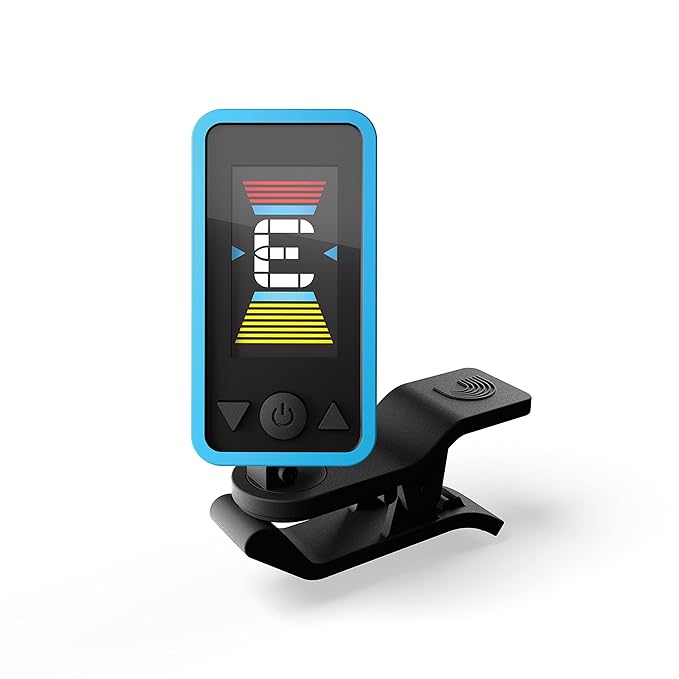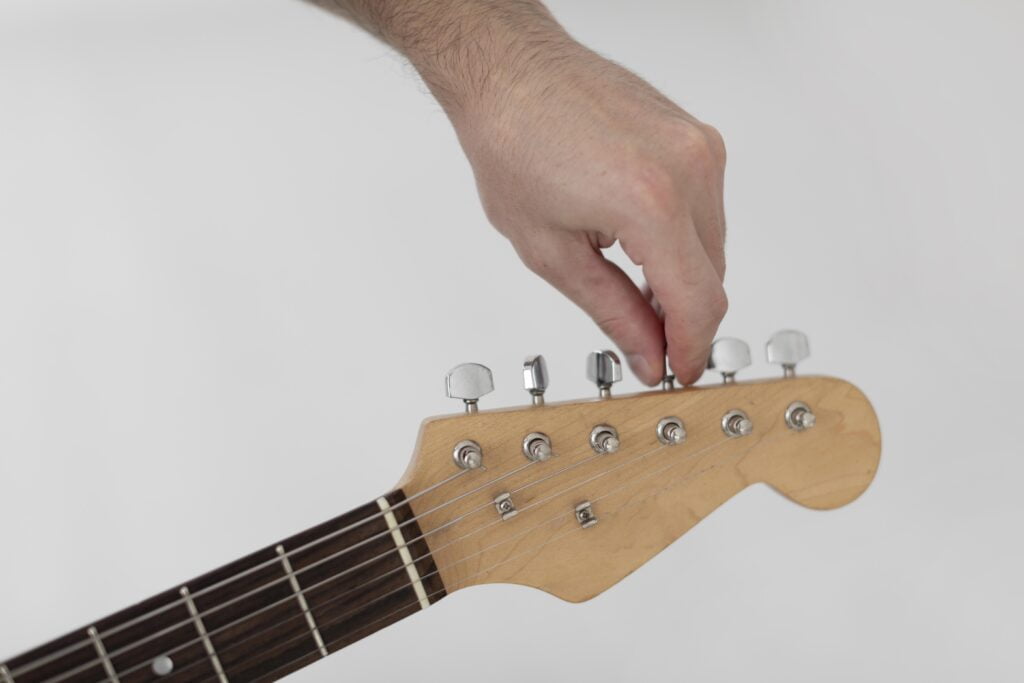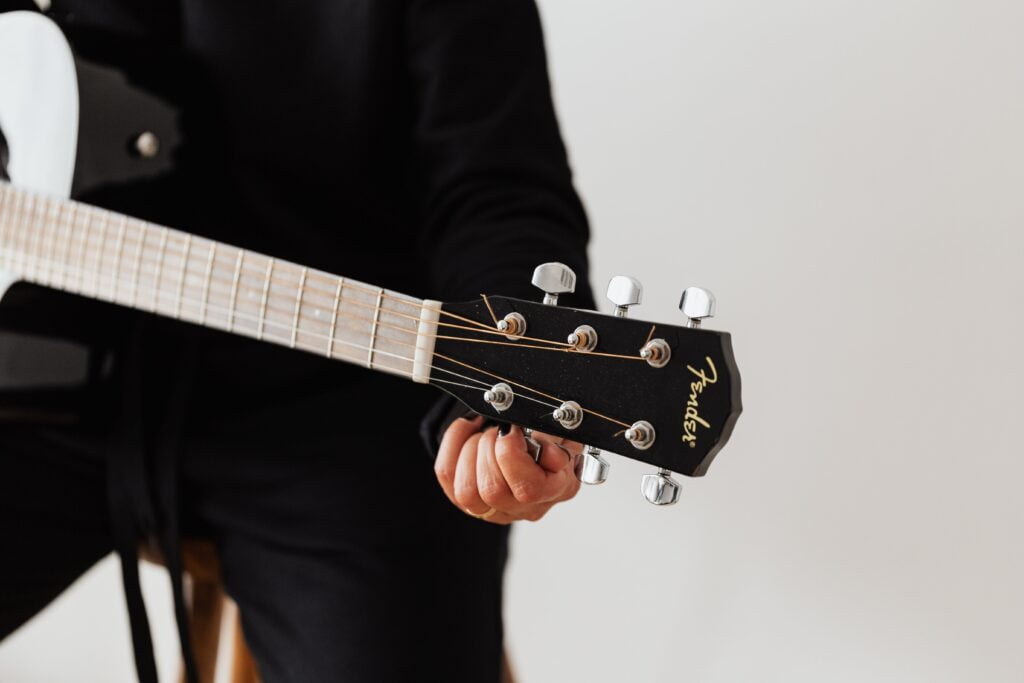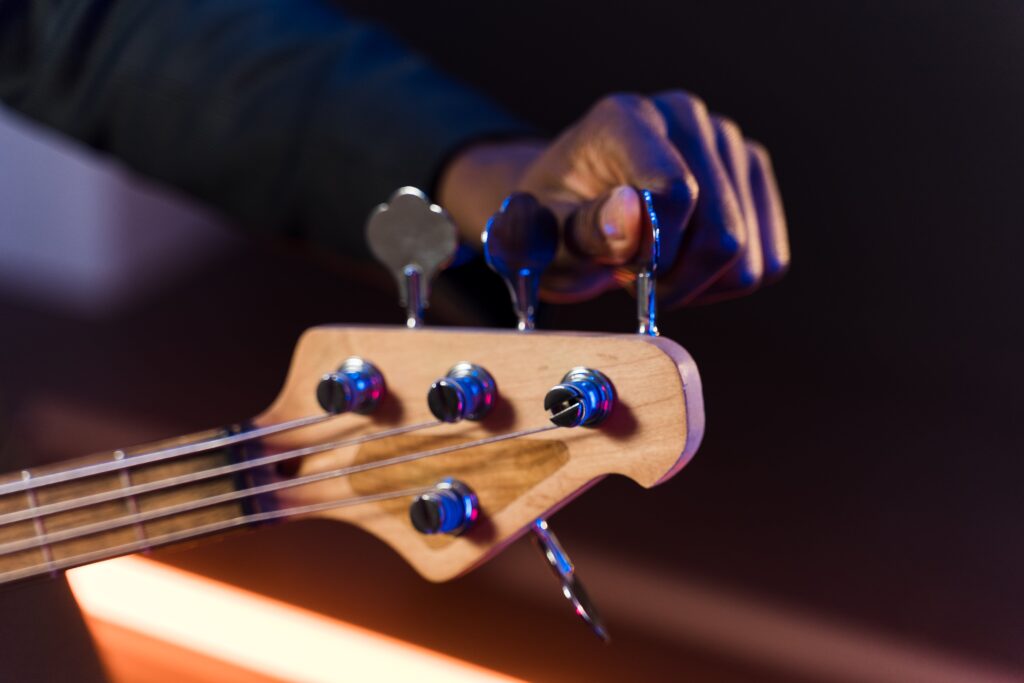Disclaimer: Some links in this article may be affiliate links. These links may earn us a small commission, but rest assured, our reviews are unbiased and not influenced by these affiliations. Your trust is our priority, and we are committed to providing honest assessments of the products we recommend.
Guitar Tuning is a essential skill for any guitar player. Not only will it make your playing sound better, but it can also help you to avoid damaging your instrument. In this article, we’ll show you how to tune a guitar using a variety of methods, including online guitar tuners, acoustic guitar tuners, and electric guitar tuners. We’ll also give you some tips on how to troubleshoot common tuning problems.
Whether you’re a beginner or a seasoned pro, keeping your guitar in tune is crucial to sounding your best. While there are many ways to tune a guitar, we’ll focus on three of the most common methods: by ear, using tuners, and by using a reference instrument.

Table of Contents
Guitar Tuning Types
There are a variety of different ways to tune a guitar, and each one produces a different sound. The most common tunings are standard tuning, drop D tuning, and open tuning.
Standard tuning is the most common tuning for a guitar. In standard tuning, the strings are tuned to the notes E, A, D, G, B, and E. This tuning is used for most types of music, including rock, pop, and blues.
Drop D tuning is a popular tuning for rock and metal guitarists. In drop D tuning, the low E string is tuned down to a D note. This gives the guitar a deeper, heavier sound.
Open tuning is often used for acoustic guitar. In open tuning, the strings are tuned to the notes D, A, D, G, A, and D. This tuning gives the guitar a brighter, more resonant sound.

There are also a variety of less common tunings, such as double drop D, half step down, and whole step down. These tunings are used for specific styles of music, such as heavy metal or slide guitar.
No matter what style of music you play, there is a guitar tuning that will suit your needs. Experiment with different tunings to find the sound that you like best.
Guitar Tuning by Ear
Tuning your guitar by ear is a skill that all guitarists should learn. It’s a great way to develop your ear, and it can come in handy when you’re in a pinch.
There are a few different ways to tune your guitar by ear. The first is to use a guitar tuning chart. You can find these online or in some guitar magazines. They’ll show you what note each string should be tuned to.
The second way is to use a guitar tuning app. There are a few different ones available, and they’ll all give you the notes that each string should be tuned to.
The third way is to use an online guitar tuning service. These services will play the notes that each string should be tuned to, and you can match them up with your own guitar.

Whichever method you use, make sure that you’re in a quiet environment so you can really focus on the notes. Start by tuning the low E string to the correct note. Then, move on to the A string, then the D string, and so on.
One thing to keep in mind is that when you’re tuning your guitar by ear, you might not always get the perfect pitch. That’s okay! Just get as close as you can, and your guitar will still sound great.
Guitar Tuning with a Tuner
When it comes to guitar tuning, there are a few different ways that you can go about it. You can either use a physical tuner, or you can use an online guitar tuner. Both have their own benefits and drawbacks, so it’s important to know what each one is before you decide which one is right for you.
Physical Tuners
Acoustic Guitar Tuning: If you’re looking for a more traditional tuning method, an acoustic guitar tuner is a great option. These devices work by attaching to the headstock of your guitar and measuring the tension of the strings. This information is then used to calculate the correct tuning for your instrument. Acoustic guitar tuners are available in both digital and analog versions.
D’Addario Eclipse Headstock Tuner

- Quick, accurate tuning
- Full color display
- Limitless viewing angles
- Tuner calibration from 430 to 450Hz.
Electric Guitar Tuning: If you have an electric guitar, you’ll need an electric guitar tuner. These devices work in much the same way as acoustic tuners, but they’re designed specifically for electric guitars. Electric guitar tuners usually have more features than their acoustic counterparts, so be sure to choose one that has the functions you need.

Physical tuners are great because they’re easy to use and they’re very accurate. However, they can be a bit pricey, and they can be a pain to carry around with you. Online guitar tuners, on the other hand, are very affordable and they’re very convenient. However, they’re not always as accurate as physical tuners.
Online Guitar Tuners
One of the easiest and most convenient ways to tune a guitar is by using an online guitar tuner. There are many different online tuners available, so be sure to find one that’s compatible with your device. Once you’ve found a tuner that works for you, simply follow the instructions on the website or app to tune your instrument.
If you’re just starting out, we recommend using an online guitar tuner. They’re very easy to use and they’re very affordable. Plus, you can use them anywhere you have an internet connection. However, if you’re looking for the most accurate tuning, we recommend using a physical tuner like the one below that we recommend.
D’Addario Eclipse Headstock Tuner

- Quick, accurate tuning
- Full color display
- Limitless viewing angles
- Tuner calibration from 430 to 450Hz.
Here’s a quick overview of how to use an online guitar tuner:
1.First, you’ll need to find a tuning website or app that you like. We recommend using Fender’s online guitar tuner.
2.Once you’re on the website or app, you’ll need to select the tuning that you want to use. Standard tuning is the most common tuning, so we recommend starting with that.
3.Next, you’ll need to pluck each string one at a time and adjust the tuning peg until the note on the screen matches the note that you’re playing.
4.Once all of the strings are in tune, you’re ready to play!
Tuning your guitar with a tuner is a quick and easy process, and it’s the most accurate way to tune your guitar. However, it’s important to remember that you don’t always need to be in perfect tune. In fact, many guitarists prefer to be slightly off-tune because it gives their playing a more “raw” sound.
If you’re just starting out, we recommend using a tuner to get your guitar in tune. However, as you become more comfortable with your guitar and your ear gets better at detecting pitch, you may find that you don’t need to use a tuner as much.
Guitar Tuning with a Reference Note or Instrument
Guitar tuning is the process of making sure your guitar’s strings are in the correct pitch. The most common guitar tuning is standard guitar tuning.
In standard guitar tuning, the strings are tuned to the following notes:
E – the lowest string
A – the second lowest string
D – the second highest string
G – the highest string
There are a few different ways that you can tune your guitar. The most common and recommended way is to use a reference note or instrument. This simply means finding a starting point (usually the lowest string) and working your way up from there.
There are a few different ways to find a reference note or instrument. One way is to use an electronic tuner like the one we recommend below. You can find these online or at most music stores. Simply pluck the string you want to tune and the tuner will tell you whether the string is too high or low. If it’s too high, you need to turn the tuning peg for that string a little bit to the left. If it’s too low, you need to turn the tuning peg a little bit to the right.
D’Addario Eclipse Headstock Tuner

- Quick, accurate tuning
- Full color display
- Limitless viewing angles
- Tuner calibration from 430 to 450Hz.
Another way to find a reference note or instrument is to use another guitar that is already in tune. Simply pluck the string you want to tune and compare it to the corresponding string on the other guitar. If it’s higher, you need to turn the tuning peg for that string a little bit to the left. If it’s lower, you need to turn the tuning peg a little bit to the right.
Finally, you can also use a piano as a reference note or instrument. Simply find the note that corresponds to the string you want to tune and pluck the string. Compare the pitch of the string to the pitch of the note on the piano. If it’s higher, you need to turn the tuning peg for that string a little bit to the left. If it’s lower, you need to turn the tuning peg a little bit to the right.

Once you’ve found a reference note or instrument, it’s simply a matter of tuning each string one at a time until they’re all in tune. Start with the lowest string (E) and work your way up. Once you’ve tuned all six strings, you’re done!
Setting the Intonation on Your Guitar
One of the most important aspects of keeping your guitar in good condition is making sure the intonation is set properly. This can be a difficult task for beginners, but once you know how, it’s easy to do and only takes a few minutes. Whether you have an acoustic, electric or bass guitar, the process is the same.
The first thing you need to do is identify the 12th fret on your guitar. This is the fret where the neck and body meet. Once you’ve located it, place your finger on the string directly above it. Now gently pluck the string and compare the sound to the open string. If they sound the same, great! If not, don’t worry, we’ll show you how to fix it.

If the 12th fret note is higher than the open string, that means the string is too tight and you need to loosen it. To do this, find the tuning peg for that string and turn it to the left. You’ll want to turn it just a little bit at a time until the note sounds the same as the open string.
If the 12th fret note is lower than the open string, that means the string is too loose and you need to tighten it. To do this, find the tuning peg for that string and turn it to the right. Again, you’ll want to turn it just a little bit at a time until the note sounds the same as the open string.
Now that you know how to set the intonation on your guitar, it’s important to check it regularly. This is especially true if you live in an area with high humidity, as that can cause your strings to expand and contract, which will affect the intonation. With a little bit of care and attention, you can keep your guitar sounding great for years to come!
Benefits of Learning Guitar Tuning
There are many benefits of learning how to tune a guitar. For one, it can help you improve your musical skills. If you can tune your own guitar, you can better control the sound that it makes. This can be helpful in a number of different situations, such as when you’re playing live or recording in the studio.
Additionally, knowing how to tune a guitar can save you money. If you’re constantly taking your guitar to the shop to have it tuned, those costs can add up over time. If you can do it yourself, you’ll be able to avoid those fees.
Finally, learning how to tune a guitar can give you a sense of satisfaction. It’s a useful skill to have, and it’s something that you can take pride in. There’s nothing quite like being able to tune your own instrument.

If you’re interested in learning how to tune a guitar, there are a few different options available to you. You can find electric guitar tuning software online, which can be helpful if you’re just getting started. Additionally, there are a number of guitar tuning apps available for both iPhone and Android devices.
No matter which method you choose, taking the time to learn how to tune a guitar can be extremely beneficial. It’s a skill that will serve you well in a number of different situations, and it’s something that you’ll be able to take pride in.
Common Guitar Tuning Problems
Unfortunately, even the best guitarists can sometimes run into tuning problems.
One of the most common problems is that the guitar tuning pegs can become loose over time. This can cause the strings to go out of tune more easily, and it can be frustrating to constantly have to retune your instrument. If you find that your tuning pegs are starting to loosen, you can try tightening them with a peg winder. If that doesn’t work, then you may need to replace the tuning pegs.
Another common problem is that the nut (the part of the guitar where the strings pass through) can become worn over time. This can cause the strings to buzz or sound muted when you play them. If you find that your nut is starting to wear down, you can try filing it down with a fine-grit sandpaper. If that doesn’t work, then you may need to replace the nut.
Finally, another common issue is that the bridge (the part of the guitar that the strings are attached to) can become misaligned. This can cause the strings to buzz or sound muted when you play them. If you find that your bridge is misaligned, you can try adjusting it with a bridge alignment tool. If that doesn’t work, then you may need to replace the bridge.

These are just a few of the most common guitar tuning problems that you may run into. If you’re having any other issues, be sure to consult a guitar technician. They’ll be able to help you diagnose the problem and get your instrument sounding great again in no time.
Tips for Keeping Your Guitar in Tune
If you’re a guitar player, then you know how important it is to keep your instrument in tune. An out-of-tune guitar can sound harsh and discordant, and can make it difficult to play even the simplest of songs. While there are a number of ways to tune a guitar, from using an electronic tuner to tuning by ear, the most important thing is to be consistent with your tuning method. In this blog post, we’ll share a few tips on how to keep your guitar in tune.
One of the most important things you can do to keep your guitar in tune is to check the tuning before you start playing. This may seem like an obvious tip, but it’s easy to forget to do this, especially if you’re in a hurry. Take a few moments to tune your guitar before you start playing, and you’ll find that it stays in tune much better throughout your session.
If you’re using an acoustic guitar, there are a few things you can do to help keep it in tune. First, make sure that the strings are properly stretched before you start playing. New strings will often go out of tune quickly, so it’s important to give them a good stretch. You can do this by gently tugging on the strings while holding down the frets.

In addition, be sure to check the tuning keys (the pegheads) periodically to make sure they’re tight. Loose tuning keys can cause the strings to slip, resulting in an out-of-tune guitar.
If you’re using an electric guitar, there are a few different things you can do to keep it in tune. First, be sure to use fresh strings. Old strings are more likely to stretch and go out of tune. Second, if you have a tremolo system on your guitar, be careful not to overuse it. Tremolo systems can cause the strings to go out of tune if they’re used too much.
Finally, one of the best things you can do to keep your guitar in tune is to practice regularly. The more you play, the better you’ll become at Tuning your instrument. Additionally, if you find that your guitar is going out of tune frequently, it’s a good idea to take it to a guitar technician to have it looked at.
Conclusion
The process of guitar tuning can be daunting for beginners. There are many factors to consider, such as the type of tuning (standard, drop D, etc.), the string gauge, and the temperature and humidity of the room. Luckily, there are a few different ways to tune your guitar, and many helpful resources available to make the process easier.
One popular method is using a tuning app on your smartphone. There are many great apps available, such as Fender Tune (Android) and Guitar Toolkit (iOS). These apps can help you tune your guitar quickly and accurately.
Another option is to use a tuning fork or pitch pipe. This is a more traditional method, and can be very effective if done correctly. Simply strike the tuning fork or pipe and hold it close to the appropriate string on your guitar. Adjust the string until it is in tune with the pitch of the fork or pipe.

Once you have your guitar in tune, it’s time to start playing! If you’re new to the instrument, you may want to start by learning some basic chords. There are many online tutorials and resources available to help you get started. Soon you’ll be playing your favorite songs with ease.
Hopefully, this article has helped to answer some of the questions you might have had about tuning your guitar. Remember, the process might seem a bit daunting at first, but with a bit of practice, you’ll be able to tune your guitar like a pro in no time!
Frequently Asked Questions on Guitar Tuning
What’s the best way to tune my guitar?
There are a few different ways that you can tune your guitar. One of the most popular methods is using an electronic tuner. These devices can be found relatively cheaply, and they’re easy to use. Simply pluck each string in turn, and the tuner will tell you whether you need to tighten or loosen the string.
If you don’t have an electronic tuner, or you just want to try something different, you can also tune your guitar by ear. This method is a bit more challenging, but it’s definitely doable with a bit of practice. You’ll need to be able to distinguish between different pitches, and have a good sense of relative tuning. Start by finding a reference note, either on another guitar or from a pitch pipe. Once you have that note, tune each string of your guitar to that note. From there, you can fine tune each string by ear until everything sounds just right.
How often should I tune my guitar?
This is a bit of a tricky question, because it really depends on how often you play. If you’re just starting out, or you only play occasionally, it’s probably enough to tune your guitar before each practice session. However, if you’re a more seasoned player, or you play regularly, you might need to tune your guitar more frequently.
One thing to keep in mind is that guitars can go out of tune pretty easily, especially if they’re not properly cared for. If you notice that your guitar is starting to sound a bit off, it’s probably a good idea to give it a tune-up.
What are some signs that my guitar needs to be tuned?
There are a few different signs that your guitar might be in need of a tuning. One of the most obvious is if the strings sound out of tune when you play them. Another is if the strings feel loose or slack. This can be a sign that the strings are stretched out and need to be tightened. Finally, if the strings are making a buzzing sound when you play them, this is also an indication that they need to be tuned.
What are some common mistakes people make when tuning their guitars?
One of the most common mistakes people make when tuning their guitars is not tuning all of the strings. It’s important to remember that even if one string is in tune, the rest of the strings might not be. This can throw off your whole guitar, so it’s important to take the time to tune all of the strings.
Another common mistake is not tuning to the correct pitch. This can be a bit tricky, especially if you’re tuning by ear. Make sure you’re using a reference note that’s in tune, and be careful not to deviate too much from that note. Otherwise, your guitar will end up sounding out of tune.
Finally, one mistake that’s often made when tuning guitars is not being consistent with the tuning process. Once you’ve tuned one string, it’s important to tune the rest of the strings to that same note. This will ensure that your guitar is in tune all the way up and down the fretboard.
Disclaimer: Some links in this article may be affiliate links. These links may earn us a small commission, but rest assured, our reviews are unbiased and not influenced by these affiliations. Your trust is our priority, and we are committed to providing honest assessments of the products we recommend.